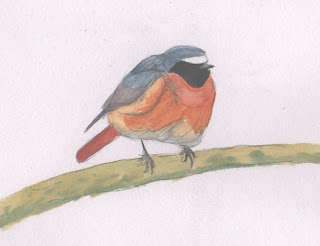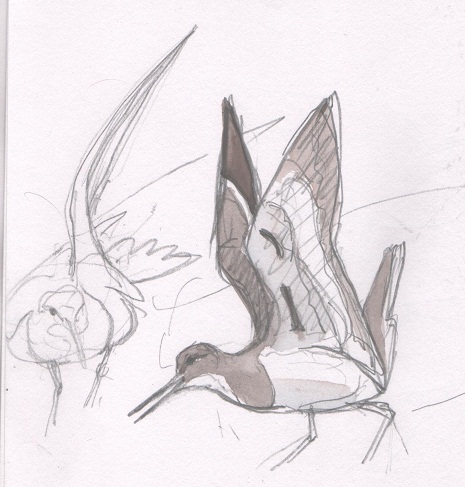Drawings, sketches and paintings of wildlife encountered on travels locally and further afield.
Tuesday, 31 December 2013
Saturday, 28 December 2013
Starling flock at Willington. We arrived at dusk and waited on a platform by the reed bed. The sky was clear and the only birds to be seen were passing gulls, then, small flocks of Starlings started to arrive from every direction and soon built into a large gathering. More and more Starlings arrived until a vast flock had congregated swirling and forming compact shapes one moment then spreading and elongating the next, splitting and rejoining. After a short while they started to stream into the reeds right in front of us which was an astounding spectacle. Parts of the flock broke away and continued to attract more incoming flocks. Eventually the whole flock poured into the reed beds and almost disappeared without trace except for their loud chatterings. Parties of birds crossed from one reed bed to the other which set off a chain reaction among the flock, causing the whole flock to shift position further along the reeds. I saw a Sparrowhawk pass right over the settled flock without disturbance. A squealing Water Rail and loud bursts of Cetti's Warbler song added to the atmosphere as we left.
Friday, 27 December 2013
Black-throated Diver. Swithland Reservoir. Watched from the dam wall. Dived every few minutes then spent a while preening. Its diving reminded me of a U-boat the way it smoothly sank underwater. Also present were 6 Scaup- immature males and females, 2 Goosander ducks, a few pairs of Goldeneye and lots of Cormorants and Great crested Grebes.
Sunday, 15 December 2013
Swimming out to open water
Wings held outside flank feathers directly before diving for food.
Sunday, 1 December 2013
Came across a group of Long-tailed Tits, Great and Blue Tits, and a single Chaffinch gathered in roadside trees. The lead bird gave a signal and one by one they flitted across the road, behind a lovely backdrop of Wollaton Hall with a winter sunset streaked with plumes from passing planes. This was painted in minutes in fast-changing light.
Sunday, 24 November 2013
Thursday, 24 October 2013
Monday, 21 October 2013
Hoopoe. Annesley Pit top. After my third visit the bird was located at the far end of the site along the track next to the lagoon. It stayed by the track probing the grassy edge. Wet and rainy much of the day. Also three Black-necked Grebes on the lagoon.
It flew quite fast and direct across the lagoon and perched in a dead Birch tree where it preened before flying off out of view.
It flew quite fast and direct across the lagoon and perched in a dead Birch tree where it preened before flying off out of view.
Wednesday, 15 May 2013
Monday, 13 May 2013
Redstart. Padley Gorge. Visited this place with the intention hopefully to see Wood Warbler and though I saw what looked like one flitting about the canopy (a pale bellied bird with a shorter, wider tail) my attention was taken by the Redstarts which posed well on the moss and lichen-covered boughs. I also heard Cuckoo and saw Tree Pipit, Winchat and of course the Pied Flycatchers which due to the unseasonable cold wind and hail flew down regularly to the ground in search of food.
Pied Flycatcher on his song perch.
Male Swallow singing from power cables.
Sunday, 12 May 2013
Saturday, 11 May 2013
Fallow Does sheltering during passing heavy showers under a Beech tree. Wollaton. As the sun came out they moved from under the trees into the open. All the females I saw are heavily pregnant and look rather plump especially fromthe back. Last years fawns are almost full grown but continue to keep close to their mothers.
Tuesday, 7 May 2013
Tree Pipit. Budby. A late evening visit to Budby heath. This bird sat for some time singing intermittently without going into the flying display.
Yellowhammer. Budby. Many birds attracted to a small pool in the track including bright Yellowhammers, Linnets, Chaffinch, Siskin, Crossbills, Blue tits and a pair of Jays.
Yellowhammer. Budby. Many birds attracted to a small pool in the track including bright Yellowhammers, Linnets, Chaffinch, Siskin, Crossbills, Blue tits and a pair of Jays.
Monday, 6 May 2013
Dotterel. Gringley Carr. A 'trip' of six birds located in the middle of a Pea field. They could be quite elusive, dropping down into furrows out of sight for some time. Some distance away their white faces were conspicuous.This sketch was completed in the afternoon with the sun behind me as an earlier attempt was less successful with sun directly in front and heat-haze. Also in this field were Golden Plover and Stock Doves. Lots of Hares about too.
Morning sketch
Gringley Carr. Part of the Pea field and drainage dyke. This area was teaming with wildlife.
Crossbill. Budby heath. A quick detour to Budby heath in the hope of seeing Cuckoo or Woodlark. Walking up the track I noticed a few small birds fly up from a pool in the path. A group of Common Crossbills perched in the small trees by the pool and waited to come down to drink. The pool was a magnet to small birds and I had close views of Crossbills, Tree Pipit, Redpoll and Siskin as well as Chaffinches and yellowhammers. This must be the nearest and only source of water for these birds. I managed to hear both Cuckoo and Woodlark.
A young male Crossbill waiting to come down for a drink. Though they were cautious about coming to drink they sat in the trees for ages unconcerned even when a group of brightly clothed bank holiday walkers trouped passed.
Adult male Crossbill.
Quick sketches of Tree Pipits 'parachuting' display. Lovely to watch they make a plaintive pew-pew-pew as they descend.
Redpoll. Came to drink at the pool as I stood a few feet away.
Redpoll. Came to drink at the pool as I stood a few feet away.
Monday, 29 April 2013
Sunday, 28 April 2013
Redstart. Padley Gorge. Brief views of these flighty, elusive birds after a full day trekking around the site. They favoured a particular area along the edge of the wood. I saw a pair (male and female)perched on the drystone wall. Earlier I saw a male fleetingly from deep within the wood itself.
The Redstarts were mainly located by their characteristic alarm call which at times sounded very faint even though the bird was only a few feet away. I heard some snatches of song though I think the weather wasnt condusive to singing.
Pied Flycatcher. Padley Gorge. A typical view of this bird. Though I saw at least 6 birds (including a couple of females) during my visit I found them incredibly hard to sketch as they never sat still longer than a few seconds and would shoot off behind the trees at the slightest movement. They did, however, make themselves known with loud song and alarm calls and would never stray far from a favoured nest box or tree-hole. I heard the meerest snippet of Wood Warbler song but will have to wait to add that one to the blog! Lots of Nuthatch; male and female Great-spotted Woodpecker; dozens of Treecreepers; Grey Wagtail and lots of the commoner species.
The Redstarts were mainly located by their characteristic alarm call which at times sounded very faint even though the bird was only a few feet away. I heard some snatches of song though I think the weather wasnt condusive to singing.
Pied Flycatcher. Padley Gorge. A typical view of this bird. Though I saw at least 6 birds (including a couple of females) during my visit I found them incredibly hard to sketch as they never sat still longer than a few seconds and would shoot off behind the trees at the slightest movement. They did, however, make themselves known with loud song and alarm calls and would never stray far from a favoured nest box or tree-hole. I heard the meerest snippet of Wood Warbler song but will have to wait to add that one to the blog! Lots of Nuthatch; male and female Great-spotted Woodpecker; dozens of Treecreepers; Grey Wagtail and lots of the commoner species.
Sunday, 21 April 2013
Corn Bunting. Barton-in-fabis. Calling from the top of a tall roadside tree. Thanks to Rob Hoare for locating and protecting these declining birds.
The Corn Bunting's call is said to sound like someone rattling a bunch of keys.
To me it has a metallic crunch quality very distinctive and evocative. Would be a massive shame if it were to disappear.
Wheatear. Field by Beeston Weir. Watching me from the middle of a field of young plants. At one point I saw its throat moving as if it were singing though it was too far away to hear.
Blackcap. Clifton Wood. Lots of singing Blackcaps in the woodland understorey by the river. This bird has a metal ring on its leg. Another one I watched had a beakful of dry grass but still couldnt stop singing!
Buzzard. Branshill. Sat on this post for some minutes constantly turning head to scan its surroundings. The wind had developed and the Buzzard angled itself for least resistance.
Common Sandpipers, Beeston Weir. Sighted on the 20th April. Two birds here mid morning and for much of the time foraged peacefully at the waters edge where stones and gravel have created a beach-like area. Occasionally the two birds paths crossed which caused a lot of posturing with wings up and chasing each other calling loudly. This was beautiful to watch but it came to an abruptend by the arrival of three youths loitering on the bank.
Sunday, 14 April 2013
Thursday, 11 April 2013
Wednesday, 10 April 2013
Subscribe to:
Comments (Atom)


















































